Food is a universal language that transcends cultural borders and unites people on a deep level in every corner of the planet.
From intimate family gatherings to extravagant feasts, the act of sharing and consuming food has always been imbued with deep symbolism and emotional significance.
Food has the remarkable ability to transcend its utilitarian purpose and become a meaningful gesture—a tangible expression of love, celebration, support, and so much more.
The goal of this post is to dive into the various ways in which food can be a strong form of communication, connection, and emotional expression.
I will explore the inherent bond between food and gestures, examining how culinary experiences have the potential to create lasting memories, forge relationships, and convey heartfelt sentiments.
Through an exploration of various aspects and contexts, I aim to uncover the transformative power of food gestures and highlight their capacity to enrich our lives.
I can develop a deeper appreciation for the role food plays in our personal life, social interactions, and even bigger cultural and societal contexts by unravelling the complexities of food as a meaningful gesture.
Whether it’s a home-cooked meal shared with loved ones, a comforting dish offered in times of distress, or a grand feast symbolizing unity and celebration, food has the ability to transcend the boundaries of language and touch our hearts in profound ways.
Join us on this illuminating trip as I discover the hidden meanings behind culinary gestures and discover how I can use food to convey our feelings, develop relationships, and cultivate a sense of community and belonging.
Together, let us savor the nourishing and transformative potential of food as a truly meaningful gesture.
See Teacher Appreciation Importance

How Food Can Be a Meaningful Gesture
The Universal Language of Food
Food is a universal language that transcends cultural and language barriers.
It has the ability to connect people from diverse backgrounds and create a sense of belonging.
When we offer food as a gesture of appreciation, we are communicating our gratitude in a way that is understood and appreciated by all.
Regardless f one’s native language or cultural traditions, the act of sharing a meal or offering a thoughtful treat conveys a message of care and appreciation.
Creating a Sense of Warmth and Comfort
Food has the incredible ability to evoke feelings of warmth and comfort.
When we prepare a delicious meal or offer a special treat, we are not only nourishing the body but also providing a source of emotional nourishment.
For teachers who dedicate their time and energy to nurturing and supporting students, a homemade meal or a thoughtful snack can serve as a comforting reminder that their efforts are valued and cherished.
Showcasing Thoughtfulness and Effort
Preparing food for someone requires thoughtfulness, planning, and effort.
It shows that we have taken the time to consider their preferences, dietary needs, and taste preferences.
When we go the extra mile to create a meal or treat that is tailored to the recipient’s liking, it demonstrates a level of care and thoughtfulness that goes beyond words.
Teachers appreciate the attention to detail and effort put into creating a meaningful culinary gesture.
Cultivating a Sense of Community
Food has the power to bring people together and foster a sense of community.
When we share a meal or offer food as a gesture of appreciation, we are creating a shared experience that strengthens bonds and cultivates a sense of belonging.
Teachers often work collaboratively with colleagues, parents, and students’ families.
By inviting them to share a meal or offering a treat, we create an opportunity for connection, collaboration, and the building of a supportive educational community.
Celebrating Cultural Diversity
Food is deeply intertwined with culture and tradition.
By offering food as a gesture of appreciation, we embrace and celebrate the diverse cultural backgrounds of teachers.
It provides an opportunity to explore different cuisines, traditions, and culinary customs.
Teachers appreciate the chance to experience new flavors and dishes, which in turn fosters a sense of inclusivity and appreciation for cultural diversity within the educational environment.
A Sustaining and Energizing Gesture
Teaching is a demanding profession that requires energy, focus, and stamina.
By offering food as a gesture of appreciation, we provide teachers with sustenance and energy to fuel their work.
Whether it’s a nutritious snack to enjoy during a busy day or a well-prepared meal to enjoy at home, food serves as a tangible reminder that their well-being is valued and prioritized.
The Role of Food in Expressing Emotions
Food has the uncanny potential to be a powerful conduit for conveying a wide range of emotions.
Beyond its physical sustenance, it carries with it the capacity to convey love, care, joy, sympathy, and support.
Across cultures and generations, food has been utilized as a medium to communicate and express our deepest sentiments.
A. Using food to convey love and care
In countless households, preparing and sharing food is a tangible manifestation of love and care.
From a parent’s warm embrace through a home-cooked meal to a partner’s thoughtful surprise dinner, food becomes a vehicle for nurturing and demonstrating affection.
The time, effort, and attention devoted to selecting ingredients, cooking with love, and presenting a beautifully crafted dish create a sensory experience that speaks directly to the heart.
B. Food as a symbol of celebration and joy
Food plays an integral role in celebrations and joyous occasions.
Whether it’s a birthday, a wedding, or a festive holiday, special dishes and delicacies are prepared to mark these moments of happiness.
The act of sharing and consuming these culinary delights becomes a communal experience, fostering a sense of unity and creating lasting memories.
Food, in this context, becomes a tangible expression of shared joy and collective celebration.
C. How food can express sympathy and support
During times of grief or hardship, food gestures have the power to provide solace and convey heartfelt sympathy.
Friends and loved ones often prepare and offer comforting meals to those in need, recognizing the nourishment that goes beyond physical sustenance.
Delivering a hot casserole, a pot of soup, or a basket of fresh fruits can provide much-needed comfort and support, letting recipients know they are not alone in their troubles.
Food gestures have an extraordinary capacity to express emotions that words alone often fail to capture.
The flavors, aromas, and textures of the dishes I create and share become an embodiment of our deepest feelings.
Whether it’s through the act of cooking with love, preparing a feast to celebrate a milestone, or offering a comforting dish during challenging times, food has the power to speak volumes and touch the souls of both the giver and the receiver.
In the subsequent sections, I will further explore the myriad ways in which food serves as a language of emotions, connection, appreciation, comfort, tradition, and even social change.
By understanding and embracing the role of food in expressing emotions, I can unlock its potential to strengthen our relationships, foster understanding, and create profound and lasting connections.
Food as a Means of Connection and Bonding
Food has an amazing capacity to bring people together, build relationships, and foster strong friendships.
It serves as a catalyst for social interactions, providing a shared experience that transcends differences and unites individuals in a common pursuit of nourishment and enjoyment.
Let’s explore how food acts as a means of connection and bonding.
A. Sharing meals as a way to build relationships
Gathering around a table to share a meal is an age-old tradition that transcends cultural and geographical boundaries.
The act of breaking bread together encourages conversation, laughter, and the building of relationships.
It fosters a sense of belonging and camaraderie by providing a space for connection and learning about one another.
Whether it’s a family dinner, a casual gathering with friends, or a communal feast, sharing meals provides an opportunity for meaningful connections to form.
B. Breaking barriers and fostering unity through food
Food has the capacity to bridge gaps and bring individuals from diverse backgrounds and cultures together.
Exploring cuisine from various parts of the world opens doors to new experiences and perspectives.
It encourages cultural exchange and understanding, as individuals come together to appreciate the flavors, traditions, and stories behind different dishes.
Through food, bridges are built, stereotypes are challenged, and a sense of unity and inclusivity is nurtured.
C. Cultural exchange and understanding through culinary experiences
Food offers a unique lens through which to explore and appreciate diverse cultures.
Exploring the culinary traditions of different regions provides insights into their history, values, and customs.
By engaging in culinary experiences, such as cooking classes, food tours, or shared meals with individuals from different cultural backgrounds, I gain a deeper understanding and respect for their heritage.
Food becomes a conduit for cultural exchange, fostering empathy, and promoting a sense of global community.
Food, beyond its physical sustenance, holds the power to connect people on a fundamental level.
Through shared meals, it creates spaces for relationships to flourish, barriers to be broken, and cultural understanding to be fostered.
By embracing the role of food as a means of connection and bonding, I can actively seek opportunities to share meals, engage in culinary experiences, and appreciate the richness of diversity.
In doing so, I strengthen our connections with others and contribute to a more inclusive and interconnected world.
Food as a Language of Appreciation
Food has a profound ability to convey appreciation, gratitude, and recognition.
It serves as a language of appreciation, allowing us to express our heartfelt thanks and admiration to others.
Let’s delve into the ways in which food gestures become a meaningful language of appreciation.
A. Expressing gratitude through food gestures
Preparing a meal or offering a special dish is a powerful way to express gratitude.
Whether it’s cooking a favorite meal for someone or organizing a gathering to honor and appreciate others, food becomes a tangible expression of gratitude.
The act of investing time, effort, and thought into creating a culinary experience shows the depth of appreciation we hold for someone and the desire to reciprocate their kindness or support.
B. The impact of thoughtful food gifts
Food gifts have a unique ability to convey appreciation and thoughtfulness.
Giving someone a carefully curated food item, such as a gourmet basket, homemade treats, or a personalized culinary experience, communicates a genuine sense of appreciation for their presence in our lives.
These gifts acknowledge the recipient’s preferences, interests, and tastes, highlighting the effort taken to select something special that resonates with them. read more HERE.
C. Nurturing relationships through the act of cooking for others
The act of cooking for others is an intimate gesture of appreciation.
Inviting someone into our homes and making a meal for them is a selfless act that promotes a sense of connection and appreciation.
It fosters a caring climate in which relationships can thrive, allowing us to strengthen our links with loved ones and express our thanks for their presence in our lives.
Food gestures serve as a language of appreciation that transcends words.
They allow us to tangibly demonstrate our gratitude and admiration for others, showing them that their presence and contributions are valued.
By utilizing food as a language of appreciation, I can nurture our relationships, strengthen connections, and create a culture of gratitude and kindness.
In the subsequent sections, I will further explore the transformative power of food gestures, including their role in providing comfort and healing, preserving cultural traditions, and driving social change.
By understanding and harnessing the language of appreciation through food, I can cultivate a culture of gratitude and foster deeper connections with the people around us.
V. Food as a Gesture of Comfort and Healing
During stressful circumstances, food has an amazing capacity to give comfort, peace, and healing.
It serves as more than mere sustenance—it becomes a gesture of care, empathy, and support.
Let’s explore how food gestures can offer comfort and contribute to the healing process.
A. The soothing and therapeutic effects of comfort food
Comfort food holds a special place in our hearts and can provide a sense of emotional solace.
Comfort food, whether it’s a steaming cup of soup, a sumptuous dessert, or a dish reminiscent of childhood memories, has a way of healing our souls during times of adversity.
The familiar flavors and textures evoke a sense of comfort, offering a temporary respite from stress or sadness.
It becomes a tangible expression of care and a reminder that I am not alone in our struggles.
B. Food as a source of solace during difficult times
Food gestures can serve as a source of solace during challenging moments.
When faced with loss, illness, or emotional hardships, the act of preparing and sharing food can provide a sense of comfort and normalcy.
Friends and family often rally together, preparing meals and delivering them to those in need.
These acts of nourishment and support convey care and empathy, offering a tangible reminder that others are there to provide sustenance and emotional support.
C. How food gestures can provide emotional support
Food gestures have the power to offer emotional support beyond their nutritional value.
The act of preparing a meal for someone going through a difficult time demonstrates compassion and a desire to provide comfort.
Sharing a meal gives a secure area for people to express their feelings, tell their stories, and receive the support they require.
Food becomes a symbol of care and a gesture that communicates, “I am here for you.”
Food, as a gesture of comfort and healing, transcends the boundaries of language and communicates empathy and support in times of need.
It acknowledges the emotional aspects of nourishment and recognizes that food can provide more than physical sustenance—it can nourish the soul as well.
By utilizing food gestures as a means of comfort and healing, I can extend care and compassion to others and contribute to their overall well-being.
In the subsequent sections, I will further explore the ways in which food gestures can express sympathy, bridge cultural divides, and preserve traditions.
By understanding the power of food as a gesture of comfort and healing, I can harness its potential to provide solace, support, and resilience during challenging times.
VI. Food as a Symbol of Tradition and Heritage
Food serves as a powerful symbol of tradition and heritage, preserving cultural practices and celebrating the richness of our collective history.
Through traditional recipes, cooking techniques, and culinary rituals, food becomes a tangible connection to our roots and an expression of our identity.
Let’s explore the significance of food as a symbol of tradition and heritage.
A. Preserving cultural practices through traditional recipes
Traditional recipes are more than just instructions for preparing a meal; they are a link to our cultural heritage.
Passed down through generations, these recipes carry with them the flavors, techniques, and stories that define our cultural identity.
By cooking and sharing traditional dishes, I preserve and honor the culinary practices of our ancestors, keeping our heritage alive for future generations.
B. Culinary rituals and celebrations of cultural identity
Culinary rituals and celebrations play a pivotal role in preserving and showcasing cultural identity.
Festivals, holidays, and special occasions often involve specific traditional dishes and culinary customs.
These rituals serve as a collective expression of our heritage, bringing communities together and reinforcing a sense of belonging.
They allow us to recognize our cultural roots, share tales, and pass on treasured traditions to future generations.
C. Food as a means of cultural exchange and understanding
Food becomes a bridge that connects different cultures, allowing for the exchange of traditions and fostering cultural understanding.
Exploring the cuisines of other cultures enables us to appreciate their history, values, and unique culinary practices.
By embracing and learning from one another’s food traditions, I cultivate respect, curiosity, and a deeper understanding of the diverse tapestry of our global community.
Food, as a symbol of tradition and heritage, carries the weight of generations past and represents the collective identity of a community.
It is a vehicle for cultural expression, allowing us to honor our roots, celebrate our diversity, and instill pride in our heritage.
By valuing and preserving our food traditions, I contribute to the rich tapestry of human history and ensure that the stories and flavors of our ancestors continue to be cherished.
In the following parts, I will delve more into the transforming power of food as a catalyst for social change, as well as its role in community building and inclusivity.
By understanding the significance of food as a symbol of tradition and heritage, I can actively engage in preserving and celebrating our cultural identities.
The Impact of Food on Social Movements and Advocacy
Throughout history, food has played an important role in social movements and advocacy activities, serving as a catalyst for change, a symbol of solidarity, and a method of raising awareness.
Its ability to connect people, evoke emotions, and inspire action makes it a powerful tool for driving social transformation.
Let’s explore the impact of food on social movements and advocacy.
A. Food as a vehicle for cultural and social change
Food has the ability to question societal norms, dismantle obstacles, and transform cultural narratives.
Food has been utilized throughout history to campaign for equality, justice, and the acknowledgement of underprivileged communities.
From boycotts of products associated with oppressive systems to the promotion of sustainable and ethical food practices, food becomes a vehicle for cultural and social change, sparking conversations and inspiring collective action.
B. Food as a symbol of resistance and solidarity
In times of social and political unrest, food gestures have served as powerful symbols of resistance and solidarity.
Shared meals, potlucks, and community kitchens have been utilized as spaces for activists to gather, strategize, and strengthen their bonds.
Food becomes a tangible expression of unity, nourishing not only the body but also the collective spirit.
By sharing meals and culinary traditions, individuals come together, transcending differences and working towards common goals.
C. Raising awareness through food-based campaigns
Food-based initiatives have been shown to be effective at raising awareness about a variety of social and environmental issues.
From promoting sustainable farming practices to advocating for food justice and combating food waste, these campaigns utilize the universal language of food to educate, engage, and mobilize communities.
By highlighting the interconnectedness of food systems with broader social issues, these campaigns inspire individuals to take action and make conscious choices that contribute to a more just and equitable world.
Food, as a tool for social movements and advocacy, transcends the confines of the dining table.
Its impact reaches far beyond nourishment, as it becomes a vehicle for cultural transformation, a symbol of resistance, and a catalyst for raising awareness.
I can effect significant change, challenge unjust systems, and build a more inclusive and sustainable future by leveraging the power of food in social movements.
In the subsequent sections, I will further explore the ways in which food fosters community building, promotes inclusivity, and supports sustainable practices.
By understanding the impact of food on social movements and advocacy, I can actively participate in shaping a better world through the choices I make around food.
Exploring the Psychology of Food Gestures
Food gestures have a significant impact on our psychological well-being, altering our emotions, perceptions, and interpersonal interactions.
The psychology of food gestures delves into the intricate ways in which food influences our thoughts, behaviours, and overall satisfaction.
Let’s delve into the fascinating world of the psychology behind food gestures.
A. The emotional power of food
Food holds a deep emotional significance that can evoke a range of emotions.
Certain foods can trigger nostalgia, bringing back cherished memories and eliciting feelings of comfort and happiness.
Other meals can improve your mood by increasing serotonin levels and fostering a sense of well-being.
Understanding the emotional power of food allows us to harness its potential to enhance our emotional states and create positive experiences.
B. The role of food in social bonding
Food gestures play a pivotal role in social bonding and interpersonal relationships.
Sharing food with people fosters a sense of belonging, trust, and companionship.
It builds a greater understanding and admiration for one another by creating a shared experience.
Food also serves as a social lubricant, enhancing the ease and enjoyment of relationships.
By recognizing the social significance of food, I can utilize it as a tool to strengthen our relationships and build meaningful connections.
C. Food and self-expression
The food I eat and how I present it can both be forms of self-expression.
Our culinary selections might reflect our cultural heritage, personal beliefs, and nutritional habits.
By carefully selecting and preparing food, I communicate aspects of my identity and convey messages about who I am.
Food gestures can be used as a creative outlet to express our individuality, showcase our culinary skills, and share our unique perspectives with others.
D. The psychology of giving and receiving food gestures
Both giving and receiving food gestures have psychological fulfillments. Offering food to others is a gesture of care, generosity, and nurturing.
It boosts self-esteem and generates a sense of accomplishment.
Receiving food gestures, on the other hand, might inspire feelings of gratitude, appreciation, and a sense of being cared for.
The exchange of food gestures strengthens interpersonal bonds and contributes to overall well-being.
Understanding the psychology of food gestures allows us to appreciate the many ways they affect our lives.
From their ability to evoke emotions and strengthen social bonds to their role in self-expression and nurturing relationships, food gestures shape our experiences and contribute to our psychological well-being.
In the following parts, I will go through how to use food gestures in everyday life, the value of mindful eating, and practical strategies for incorporating meaningful food gestures into our routines.
By deepening our understanding of the psychology of food gestures, I can cultivate a healthier relationship with food and harness its transformative power in our lives.
Food as a Gesture of Apology and Reconciliation
Food gestures have the remarkable ability to convey remorse, extend apologies, and foster reconciliation in times of conflict or misunderstanding.
By offering food as a gesture of apology, I acknowledge the impact of our actions, express genuine remorse, and seek to rebuild trust.
Let’s explore the power of food as a means of apology and reconciliation.
A. Food as a tangible expression of remorse
In many cultures, preparing and sharing food is seen as a sincere way to demonstrate remorse and seek forgiveness.
By investing time and effort into preparing a thoughtful meal, I show our commitment to making amends.
The act of offering food becomes a tangible expression of remorse, highlighting our desire to rectify our actions and heal the relationship.
B. The role of shared meals in reconciliation
Shared meals have long been used as a means of reconciling differences and fostering understanding.
Sitting down together to share a meal creates a safe and neutral space for open dialogue and genuine conversation.
Breaking bread together can facilitate communication, empathy, and the building of bridges, allowing both parties to express their perspectives and work towards reconciliation.
C. Food gestures as acts of peacebuilding
Food gestures can serve as acts of peacebuilding, transcending cultural and societal boundaries.
In situations of conflict or tension, offering food as an olive branch demonstrates a genuine desire to resolve differences and restore harmony.
Food becomes a symbol of unity and shared humanity, emphasizing our common needs and aspirations.
D. The transformative power of food rituals
Food rituals and traditions can play a significant role in apology and reconciliation processes.
In some cultures, specific dishes or rituals are associated with forgiveness and restoration of relationships.
Individuals can actively participate in the process of healing and reconciliation by participating in these rituals, which deepens their understanding of one another and fosters a sense of forgiveness.
Food, as a gesture of apology and reconciliation, transcends mere words.
It conveys humility, remorse, and a sincere desire to mend relationships.
By utilizing food gestures as a means of apology, I open the door to healing, understanding, and the rebuilding of trust.
In the subsequent sections, I will further explore the ways in which food can promote empathy and forgiveness, the significance of shared meals in conflict resolution, and practical tips for utilizing food gestures to seek reconciliation.
By embracing the power of food in apology and reconciliation, I can contribute to building stronger and more harmonious relationships.
Summary
Food gestures hold immense significance in our lives, extending beyond mere nourishment.
They serve as powerful tools for communication, connection, and the expression of emotions.
Throughout this article, I have explored various aspects of food gestures and their profound impact on our lives and relationships.
I began by understanding the role of food as a meaningful gesture, acknowledging its ability to convey emotions, strengthen bonds, and foster connections.
I delved into the ways food serves as a language of appreciation, comfort, and healing, offering solace during difficult times and providing emotional support.
Furthermore, I recognized food as a symbol of tradition and heritage, preserving cultural practices and celebrating our collective history. Through traditional recipes, culinary rituals, and cultural exchange, food becomes a tangible connection to our roots and an expression of our identity.
Food’s role in social movements and advocacy was also explored, showcasing its power to drive change, symbolize resistance, and raise awareness.
From promoting equality to advocating for sustainable practices, food becomes a catalyst for social transformation and a means of promoting a more just and equitable world.
The psychology of food gestures revealed their impact on our emotions, social bonds, and self-expression.
I learned how food can evoke nostalgia, enhance social connections, and act as a form of apology and reconciliation, mending relationships and fostering understanding.
In conclusion, food gestures possess a profound ability to transcend cultural, emotional, and social barriers.
By harnessing their meaningful power, I can build stronger communities, bridge divides, and promote empathy and understanding.
Through food, I communicate love, appreciation, and a desire for connection.
Let us embrace the transformative potential of food gestures and utilize them to create a more compassionate and inclusive world.
See Top 5 Most Useless Courses to Study in Nigeria Universities And why
FAQs
1. Can food gestures truly convey emotions? Yes, food gestures have a unique ability to convey a wide range of emotions. The choice of ingredients, the care put into preparation, and the act of sharing food all contribute to the emotional impact it carries.
2. How can food gestures promote cultural understanding? Food gestures provide a platform for cultural exchange and appreciation. Exploring different cuisines and sharing traditional meals allows individuals to learn about one another’s heritage, fostering understanding and respect.
3. Are food gestures effective in social movements and advocacy? Absolutely. Food-based campaigns and food-related events have been successful in raising awareness about social and environmental issues. Food serves as a universal language that can engage and mobilize communities towards positive change.
4. How can I use food gestures to mend relationships? Offering food as a gesture of apology and reconciliation shows genuine remorse and a desire to rebuild trust. Sharing a meal together creates an opportunity for open dialogue and understanding, facilitating the healing process.
5. Can food gestures improve mental well-being? Yes, food gestures can positively impact mental well-being. The emotional power of food, the social connections it fosters, and the sense of satisfaction it brings all contribute to a healthier and more balanced state of mind.
Remember, the power of food gestures lies in our willingness to embrace their significance and actively engage with them.
By recognizing the meaningful role food plays in our lives, I can harness its potential to foster connection, understanding, and positive change.
See Teacher Appreciation Food Ideas
Conclusion
Food has a unique way of communicating emotions, building connections, and expressing gratitude.
When it comes to appreciating teachers, food can be a meaningful and powerful gesture.
It transcends language barriers, creates a sense of warmth and comfort, showcases thoughtfulness, cultivates community, celebrates diversity, and sustains teachers in their important work.
So, let us embrace the power of food and use it as a heartfelt expression of appreciation for the dedicated teachers who shape the minds of our future generations.
NGschoolBoard is not just a blog, but a project designed to make students’ research easy and faster. We have a dedicated team of staff working tirelessly to make sure you get quality information from our blog and all other features we will be rolling out soon. do well to subscribe to an email subscription so that you don’t miss out on our latest updates. Shalom!!!






Teacher Appreciation Food Ideas 2023- Delicious Recipes to Celebrate Teachers - NGschoolBoard
[…] When it comes to expressing appreciation and gratitude, food can be a meaningful and heartfelt gesture. read more HERE. […]
No cost Teacher Appreciation Ideas 2023 - NGschoolBoard
[…] See How Food Can Be a Meaningful Gesture […]